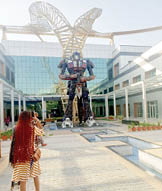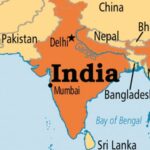India, a 77-year-old independent country, is exploring its rich and diverse culture, and major developments and initiatives for global attention.
This was seen during a recent eight-day familiarisation visit by 31 journalists from 10 countries in Central and West Africa, including Nigeria, Ghana, Angola, Cote d’voire, Democratic Republic of Congo, Equatorial Guinea, Niger Republic, Congo-Brazzaville, Republic of Guinea and Togo.
The tour, facilitated by the External Language Media Section of the Indian Ministry of External Affairs, offered a glimpse of the Asian country’s efforts towards prosperity, sustainable development, poverty alleviation, national unity promotion and cultural preservation.
Lakhpati Didi Initiative: Grooming entrepreneurs to alleviate poverty
A report by the World Bank on October 15, 2024, approximates that 120 million of the India’s 1.429 billion population are living in extreme poverty, earning below Rs181 ($2.15) daily. However, the Indian Government is tackling poverty through a programme tagged: Deendayal Antyodaya Yojana-National Rural Livelihoods Mission (DAY-NRLM) which is a flagship of the country’s Ministry of Rural Development.
- Hardship: Prioritise Nigerians’ welfare, Osinbajo tells Tinubu
- Judges, politicians, clerics, security agencies in Nigeria: A parade of pretenders
The initiative, which has presence in 742 districts across India, promotes sustainable livelihoods for the poor and mobilises rural women into Lakhpati Didis, otherwise known as Self-Help Groups (SHGs). The scheme provides an institutional platform for access to credit facilities, skills development and economic opportunities through livelihoods and market linkages.
Shri Charanjit Singh, Additional Secretary, Rural Livelihoods, Ministry of Rural Development, told the visiting journalists, at a reception in Gurugram, that since its launch in 2011, the initiative had mobilised over 100 million Indian women into 9.1 million self-help groups and established bank linkages of over $114 billion, with the capitalisation support of $5.7 billion across 47,068 credit units.
“In India, it is firmly believed that the poor are not equipped adequately and need help. We train them to make livings out of their lives. We have 100 million households assisted by the World Bank and organisation that work on development issues. We give them (the households) loans. The Reserves Bank of India coordinates this.
“It is to reduce poverty by enabling the poor households to access gainful employment sand skilled waged employment opportunities, resulting in appreciable improvement in their livelihoods on a sustainable basis through building strong grassroots institutions of the poor,” he said.
Singh explained why the initiative is for only women: “Our motto is strong women, prosperous India. It (the initiative) encourages women to form groups of 10 to 20 members each. They start with meetings that promote collective savings and lending. They open a joint account in the second month, promoting financial inclusion.
“The third to fourth month brings support in form of a revolving support fund from government. This is where bigger credits are accessed for various businesses and expansion in bank credit linkages.”
He listed the benefits for enrollees as including financial literacy, health insurance, pension as well as digital and enterprise funding.
Saras Ajeevika Mela: A trade fair empowering women
Saras Ajeevika Mela is a trade fair that empowers rural women by providing them a platform to showcase traditional Indian arts and culture, including handcrafted products by artisans.
The trade fair, handled by the National Institute of Rural Development, markets rural products. This year’s edition of the fair, which was the third, was held from October 13 to 29 at Leisure Valley Ground in Sector 29, Gurugram District, located 30km south of New Delhi.
Over 900 female artisans from villages across 30 Indian states, who partook in the trade fair, set up about 500 stalls to showcase such products as jute bags, brass bell metal artefacts, channapatna toys, madhubani art folders, scented candles, Tussar sarees, Bagh prints, Patola sarees from Gujarat; Katha sarees from West Bengal; rajasthani prints, Chanderi sarees from Madhya Pradesh; wooden products and natural food products from Kamataka and Andhra Pradesh; dry fruits and handloom products from Jammu and Kashmir; palash products, among others.
The trade fair also featured a kids’ zone, mother care rooms and facilities for elderly visitors as well as food pavilions that showcased regional dishes.
On the significance of the trade fair to the India’s economy, Singh said: “If the nation wants to be a leading country in the world, over 50 percent of the population must be able to contribute to the economy. That is what this initiative is all about.
“We recognise the need to engage women to lift their families out of poverty. The initiative is not just for social inclusion and mobilisation of women, but also for households’ support. More so, the women have proven to be trustworthy and disciplined in handling finances and repaying loans.”
The Statue of Unity: Promoting India’s national unity
Sited in the state of Gujarat on the River Narmada, near Kevadiya, the Statue of Unity, which faces the Sardar Sarovar Dam, symbolises India’s national unity as well as its rich history and struggle for independence.
It is the iconic statue of Sardar Vallabhbhai Patel, Indian statesman, freedom fighter, independence activist, first Deputy Prime Minister and Home Minister who lived from 1875 to 1950. Esteemed as “the iron man of India”, Patel was said to have united 556 kingdoms in India. He was a disciple of Mahatma Gandhi.
The project of the statue was announced in 2010, but the construction, which said to have gulped $422 million, began on October 31, 2013 by an indigenous company, Larsen & Toubro. The statue, constructed with bronze, was unveiled by Prime Minister Narendra Modi on October 31, 2018, Patel’s 143rd birthday anniversary. As a mark of honour for Patel, India observes its National Unity Day on October 31.
The Statue of Unity, designed by an Indian sculptor, Ram Sutar, is the world’s
tallest statue towering at 182 metres (597 feet). It is higher than the earlier tallest Statue of Spring Temple Buddah in China (153m).
It is also taller than the Statue of Ushiku Daibutsu in Japan (120m), the Statue of Liberty in New York (93m), the Statue of the Motherland Calls in Russia (85m) and the Statue of the Christ the Redeemer in Brazil (38m). It is also one-and-a-half times of the Sardar Sarovar Dam.
Around the site of the Statue of Unity are a museum, an exhibition hall and a viewing gallery.
Rahul Patel, who conducted the visiting journalists round the statue, said it attracts millions of tourists to the Indian State of Gujarat annually. The statue was said to have attracted nearly 20 million tourists since 2018 and generated an estimated $12 million revenue in the first year alone.
National Institute of Design: Building a design-conscious India
Regarded as a foremost design school in Asia, the institute, located in Paldi, Ahmedabad, is a public university established in 1961, with campuses in Gandhinagar and Bengaluru.
The institute, headed by Dr Ashok Mondal, is focused on building “a design-conscious society that fosters innovation and invention by framing and solving problems, staging experiences and speculating futures in the service of our collective well-being.”
Alongside other NDIs in Kurukshetra, Bhopal, Amaravati and Jorhat, the institute operates as an autonomous institute under the Department for Promotion of Industry and Internal Trade, Ministry of Commerce and Industry. It offers bachelor’s degree, graduate diploma, master’s degree and doctoral programmes in universal design, apparel design, lifestyle accessory design, photography design, strategic design management, toy and game design, transportation and automobile design, design for rental experience, digital game design, information design, interaction design, universal design, animation film design, exhibition design, film and video communication, filmmaking, animation.
Coalition for Disaster Resilient Infrastructure (CDRI)
India is spearheading global efforts against disasters through the Coalition for Disaster Resilient Infrastructure (CDRI) launched by Prime Minister Shri Narendra Modi at the 2019 United Nations Climate Action Summit.
The CDRI is a global partnership of national governments, United Nations agencies and programmes, multilateral development banks and financial mechanisms, the private sector and academia aimed at promoting the resilience of new and existing infrastructure systems to climate and disaster risks in support of sustainable development.
It provides disaster response and recovery support, innovation, institutional and community capacity-building assistance, among other services.
Senior Director, Programme Management and Technical Support, CDRI, Ramraj Narsimhan, said if Nigeria and other African countries join the Coalition, it would help them to address flooding and other natural hazards.
According to him, the CDRI, which currently has 40 members, seeks to become the platform to partner and advocate over $10 trillion infrastructure investments and services resilient to disasters and climate change through enhanced capacity, informed policy, planning and management that would lead to improved quality of environment, livelihoods and lives of over three billion people by 2050.
Harnessing the Global South for prosperity
India is using the Global South as a platform for developing nations to unite and forge a stronger South-South cooperation.
Special Secretary, Economic Relations and Development Partners Administration, Indian Ministry of External Affairs, Periasamy Kumaran, said India’s foreign policy towards Africa is based on four pillars of development partnership and capacity building, trade and investment, strong people-to-people ties, and defence and maritime security.
He emphasised that India’s priorities are guided by the principles of non-interference and mutual respect.
“The Global South represents not just geography but shared historical experiences of colonialism, struggles for independence, economic exploitation and a lack of representation in global governance.
“Together, the Global South comprises 85 percent of the world’s population, and our development needs must be central to the global governance agenda.
“India envisions a common future with the Global South. Our G20 Presidency in 2023 allowed us to elevate the concerns of developing countries, leading to the inclusion of the African Union as a permanent member of the G20,” Kumaran said.
He also disclosed that India’s trade with Africa had hit $100 billion with cumulative investments of over $75 billion on the continent.
Amul: ‘The milk of progress’
Amul is a 78-year-old diary brand owned by thousands of Indian small and medium farmers who operate under a cooperative society known as Gujarat Cooperative Milk Marketing Federation based in Anand, Gujarat. The cooperative is controlled by 3.6 million milk producers. They take their milk, extracted from cows and buffalos, to different cooperative societies in over 1,000 villages from where it is trucked to the Manufacturing Plant of Amul, India, Anand. Amul is said to be the biggest diary, not only in India, but also in Asia.
Amul is prided as milk of progress and taste of India. India, according to officials of the plant, generates $8.5 billion annual revenue from over 50 Amul products which include chocolates, peanut spread creamy, shrikhand, fresh cream, rajbhog, yoghurt, cheese, mithai mate, among others.
Gujarat Science City: Connecting community with science
The Gujarat Science City is a science education and entertainment centre which is under the Department of Science and Technology of the Government of Gujarat.
Located at the Science Road, Ahmedabad, the city was inaugurated in 2002 but was expanded in 2021. Its motto is connecting community with science.
The Science City has, among others, an IMAX 3D theatre, aquatic gallery, robotics gallery, life science park, planet earth, energy education park and nature park.
The aquatic gallery features 10 different marine areas including Indian Zone, Asian Zone, African Zone, Oceans of the World Zone and several others. Inside the aquatic gallery are 68 tanks with 188 species, over 11,600 fishes, including sharks.
The robotics gallery contains robots from different fields that demonstrate applications in agriculture, medicine, space and defence. At the reception of the gallery is humanoid robot that communicates with visitors and expresses emotions such as excitement, surprise and joy.

 Join Daily Trust WhatsApp Community For Quick Access To News and Happenings Around You.
Join Daily Trust WhatsApp Community For Quick Access To News and Happenings Around You.
